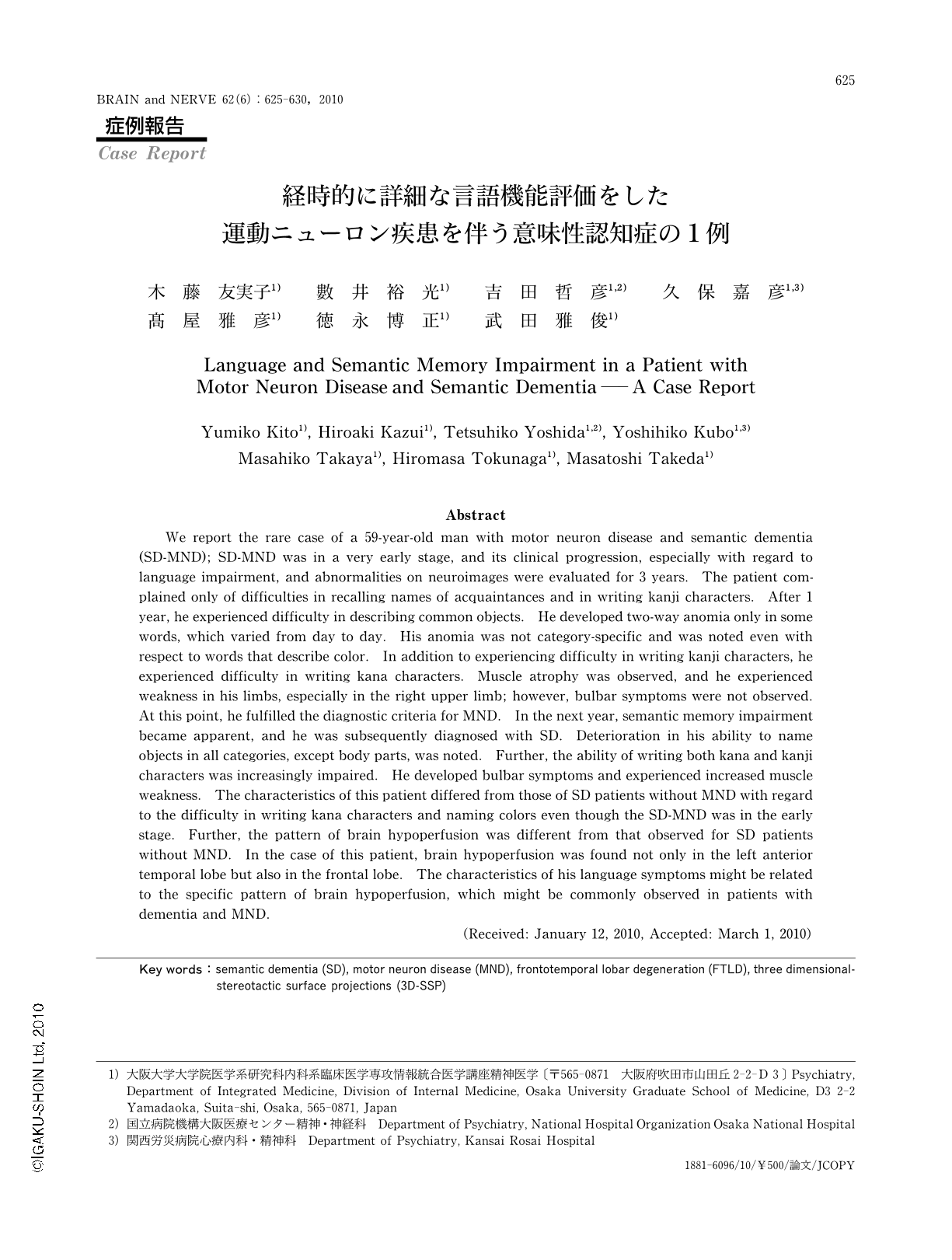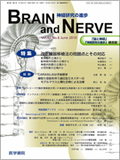Japanese
English
- 有料閲覧
- Abstract 文献概要
- 1ページ目 Look Inside
- 参考文献 Reference
はじめに
前頭側頭葉変性症(frontotemporal lobar degeneration:FTLD)は前頭葉・側頭葉の萎縮を伴う初老期発症・緩徐進行性の臨床症候群としてNearyら1)によって定義され,行動異常などを前景とする前頭側頭型認知症(frontotemporal dementia:FTD)と,失語症状を主とする意味性認知症(semantic dementia:SD)および進行性非流暢性失語に分けられる。
FTLDにはmotor neuron disease(MND)を伴う症例が存在することが知られている。MNDを伴う臨床型は,MND with dementia(D-MND)として報告された症例を含めてもFTDがほとんど2,3)で,MNDを伴うSD(SD-MND)の報告は日本から2例4,5),海外から1例6)にとどまる。しかし,病理学的検討からはSD-MND例が一定数存在することが明らかにされている7)。
FTD-MNDはMNDを伴わないFTDと比べ生存期間が短く,障害が前頭葉に限局するなど症状や画像所見が異なると報告されている8)。SD-MNDも仮名の錯書を初期から有するなどMNDを伴わないSDと異なる徴候を持つ可能性が示唆されているが詳細は不明である。
今回われわれはSD-MNDの1例を経験し,言語を含む神経心理学的評価・神経画像学的評価を2年にわたり施行したので報告する。
Abstract
We report the rare case of a 59-year-old man with motor neuron disease and semantic dementia (SD-MND); SD-MND was in a very early stage,and its clinical progression,especially with regard to language impairment,and abnormalities on neuroimages were evaluated for 3 years. The patient complained only of difficulties in recalling names of acquaintances and in writing kanji characters. After 1 year,he experienced difficulty in describing common objects. He developed two-way anomia only in some words,which varied from day to day. His anomia was not category-specific and was noted even with respect to words that describe color. In addition to experiencing difficulty in writing kanji characters,he experienced difficulty in writing kana characters. Muscle atrophy was observed,and he experienced weakness in his limbs,especially in the right upper limb; however,bulbar symptoms were not observed. At this point,he fulfilled the diagnostic criteria for MND. In the next year,semantic memory impairment became apparent,and he was subsequently diagnosed with SD. Deterioration in his ability to name objects in all categories,except body parts,was noted. Further,the ability of writing both kana and kanji characters was increasingly impaired. He developed bulbar symptoms and experienced increased muscle weakness. The characteristics of this patient differed from those of SD patients without MND with regard to the difficulty in writing kana characters and naming colors even though the SD-MND was in the early stage. Further,the pattern of brain hypoperfusion was different from that observed for SD patients without MND. In the case of this patient,brain hypoperfusion was found not only in the left anterior temporal lobe but also in the frontal lobe. The characteristics of his language symptoms might be related to the specific pattern of brain hypoperfusion,which might be commonly observed in patients with dementia and MND.
(Received: January 12,2010,Accepted: March 1,2010)

Copyright © 2010, Igaku-Shoin Ltd. All rights reserved.


